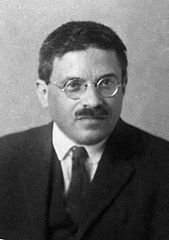
Spinning the wheel: The Ehrenfest paradox

What's the circumference of a ferris wheel?
Let's say the spoke of a bicycle wheel measures 50 centimetres. How long is its circumference?
Or let's look at a Ferris wheel that is one hundred metres high. How long is its circumference?
Easy questions: every high-school student knows that the circumference of a circle, $C$, equals $\pi$ times twice the radius. $C = 2\pi R.$
This fact has been known since antiquity. The Egyptians and Chinese had already realised that the circumference of a circle is always proportional to the circle's diameter. They believed that the factor of proportionality was a bit over three. In the 3rd century BCE, Archimedes was the first to approximate its true value more precisely. In the eighteenth century, it was proved that $\pi$ is an irrational number whose decimal expansion begins as $3.14159…$
Hence the bicycle's circumference is $3.14159…$ metres, and the circumference of the Ferris wheel is $314.159…$ metres. No matter how large or small the wheels, their circumferences are always equal to $2\pi R.$
Correct?
The paradox
Most surprisingly, no… not if the wheels spin.
But this will be noticeable only if they spin really fast. And I mean really, really fast, like speed-of-light-fast. In this case the theory of relativity gives rise to a problem.
Albert Einstein's special theory of relativity famously predicted, and the prediction was later shown to be correct, that when the speed of travelling objects approaches the speed of light, the objects' lengths contract noticeably in the direction of the motion. (This happens at any speed but only becomes noticeable at close to the speed of light.)

Albert Einstein
This is true not only for straight-line travel but also for circular motion: when a wheel spins, every point on the rim of the wheel travels in the direction of its tangent. So, according to the theory of relativity, the length of the rim gets shorter. The wheel's radius, on the other hand, does not. It is perpendicular to the motion of the wheel and does not contract. The conclusion is that even though the wheel's radius is $R,$ the circumference has become shorter than $2\pi R.$
We can also look at the situation in a different way. Let us place measuring rods end to end along the wheel's circumference. (They would have to be curved in order to align with the wheel's curvature.) Even if we assume that the wheel remains rigid, the measuring rods would contract when they spin around, thus opening up gaps between them into which additional measuring rods could be placed. So, the circumference of the spinning wheel will be able to accommodate more measuring rods than when at rest, which implies that the circumference has become longer than $2\pi R.$
So why is the circumference not equal to $2\pi R$? And if it is not equal to $2\pi R,$ is it longer or shorter?
We have a paradox on top of a paradox. This was proposed by the physicist Paul Ehrenfest in 1909, only four years after Einstein published the theory of special relativity. One of the early paradoxes of relativity theory, it has a long history of controversy and still gives rise to academic papers, more than a century later. Ehrenfest's conclusion was that bodies that go from rest to very fast rotation cannot be perfectly rigid. At speeds close to the speed of light they must undergo deformations ... and even worse, as we shall see below.
Resolution
Of course, no real physical wheel can rotate at speeds close to the speed of light. Consequently, the Ehrenfest scenario belongs to the realm of thought experiments. So let us think through the experiment: what does it mean that the wheel's circumference is reduced or that gaps form between the measuring rods? There seems to be only one answer: the wheel must be squashed or pulled asunder until it shatters. Ehrenfest's conclusion was that rigid bodies are incompatible with the theory of relativity. When angular speed accelerates towards the speed of light, the object will be deformed and torn apart.

Paul Ehrenfest
But let us assume – remaining within our thought experiment – that the wheel does stay rigid. Would the circumference become longer or shorter?
The answer to the question depends on where the observer stands. If both the observer and the wheel are at rest, the wheel's circumference is $2\pi R.$ However, when the wheel spins and the observer looks from afar at the rods spinning along at the wheel's circumference, the rods will have contracted. Hence more of these shorter rods need to be placed in the gaps. The additional rods compensate for the contraction of the initial rods, and from the observer's viewpoint the circumference remains constant at $2\pi R.$
On the other hand, an observer standing on the edge of the wheel and spinning with it undergoes the same contraction as the rods. Hence she herself does not notice any contraction and from her viewpoint, the lengths of the rods remain constant. But she does realise that gaps have opened up between the rods and she must place additional ones into the gaps. To this observer, spinning around at the edge of the wheel, the circumference has now become larger than $2\pi R$. Apart from the somewhat mysterious lengthening of the circumference she notices nothing amiss. Nevertheless, she finds herself in some version of non-Euclidean geometry.
Technical supplement
In fact, real experiments (in contrast to the thought experiment) show that Ehrenfest was not far off the mark but for reasons other than relativity theory. When objects are rotated fast enough they do shatter, and they do so much sooner than close to the speed of light. The calamity occurs already at rotational speeds close to the speed of sound: since rigid objects cannot overcome the shear forces that are exerted on it by the centrifugal forces — if those forces exceed the structural integrity of the material from which the object is made — they are torn apart.
Another thought: maybe we should rethink the idea that $\pi$ is a constant. Can we let Euclidean geometry go out the door and consider $\pi$, not a constant, but a function of angular speed? We will leave that for you to ponder.
About the author

George Szpiro |
George G. Szpiro is a Swiss/Israeli author and journalist who was a longtime correspondent for the Swiss daily Neue Zürcher Zeitung. He has held faculty positions at the Wharton School, University of Pennsylvania, and the Hebrew University in Jerusalem. His many books include Numbers Rule: The Vexing Mathematics of Democracy, from Plato to the Present (Princeton, 2010) and Risk, Choice, and Uncertainty: Three Centuries of Economic Decision-Making (Columbia, 2020). His book Perplexing paradoxes: Unraveling enigmas in the world around us, to be published by Columbia University Press towards the end of 2023, will contain sixty short chapters with paradoxes from maths, physics, logic, linguistics, economics, law, and more. | 
|